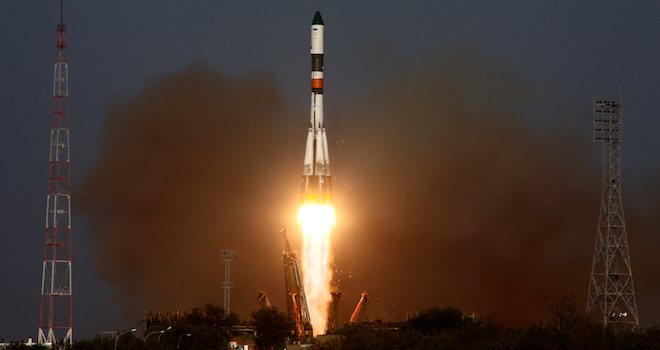Having pinpointed the flaw that lead to the crash of an unmanned Soyuz spacecraft, the Russian Space Agency has given the green light to resume launches of cargo ships beginning Oct. 30 and human-crewed missions on November 12.
“It is planned to launch Progress cargo spaceships on October 30, 2011, and on January 26, 2012. Manned Soyuz-FG spaceships will be launched on November 12 and December 20, 2011,” the agency Roscosmos said in a news bulletin posted on its website, translated into English by Universe Today.
That would seem to ease earlier fears that the International Space Station would have to be temporarily abandoned this November in the wake of the Aug. 24 crash of an unmanned, Soyuz U rocket carrying cargo for the station.
The cause of the crash was determined by an investigative commission as a clogged fuel pipe, validating an initial report that the engine’s third stage is what failed. Unfortunately, it was also found to be a manufacturing flaw, as opposed to just procedural one, which is “likely to increase jitters about Russian safety,” as The New York Times put it.
“This means that the ISS will constantly operate in piloted mode, with astronauts onboard,” Roscosmos spokesman Valery Lyndin told AFP. “Crews will be changed as originally planned, only the schedule will be somewhat pushed back.”
But at the same time, NASA has yet to confirm that it is onboard with the new Russian schedule.
“Currently, the Federal Space Agency is currently consulting with NASA to refine the work plans of the upcoming missions to the International Space Station,” Roscosmos said it its statement.
Six astronauts are currently aboard the station, including two NASA astronauts and four Russian cosmonauts. Three of them are due home on a Soyuz this Friday. The other three can’t stay aboard any longer than mid-November thanks to the safety raing Soyuz (its only rated for 210 days in space), though an exact date has yet to be determined.
The generally reliable, time-tested, 40-year-old Soyuz rockets are currently the only means of transportation to and from the International Space Station since the retirement of the Space Shuttle in July. However, they have suffered an embarrassing and confidence-shaking series of mishaps lately.
As such, NASA and the Russian Space Agency didn’t want to risk putting anything, let alone, human crews back aboard the craft until the problem that led to the crash was determined.
However, even when the space shuttle was running, it’s worth noting that the Soyuz was intergal to tours of duty on the station because a docked Soyuz was always needed to serve as the “lifeboat” to ferry crew members home in case of emergency. Thus, even if the shuttle were around today, the problem caused by the crash of the Soyuz would stand. Two Soyuz are currently docked to the station, with one expected back on Friday and the other in mid-November.
TPM’s Idea Lab has reached out to NASA and will update when we receive a response.









